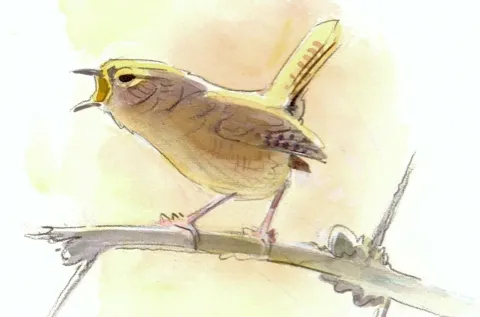January brings the first signs of spring – the beginnings of the dawn chorus – but also the continuing drama of winter survival played out on the bird table.
Though snowdrops peep unmistakably through the frosty January soil to remind every gardener that spring is making inroads into winter, early signs of the transition are much more difficult to see among birds. Yet the imminent death of the cold season is no less a reality for them; it’s just that they hide its effects much better.
The birds still appear to be fully occupied with nothing more than pure survival, as they swarm to the birdtable and bicker with each other over scraps of food. But inside, their body chemistry is saying something different.
Ever since the daylight began to increase in length in late December, their hormones have been working overtime to prepare them for the breeding season. Light-detecting cells in birds’ brains have registered the change and flicked an irreversible switch, accelerating the reproductive process.
Like stony-faced politicians keeping cool to try to head off a scandal, the birds give little or nothing away. It’s hard to see the signs.
But listen out, and you can hear them. A few bird songs slip out before the new year, and gradually more can be heard in January, day by day, until by the month’s end, there is almost a chorus.
It’s a sure sign of the changing season. The birds are not just making call notes now – the percussive ‘tick, tick’ of a robin, the scold of a blue tit, the overwrought panic-squeal of blackbird – they are singing properly, constructing considered phrases, full of meaning, and uttering them from high perches and taking their time.
The cheery, repeated chime of a great tit is a statement of territory. The loud, explosive burst of the ever-flustered wren – proving once and for all that size doesn’t matter – is a constant challenge and insult to the bird next door.
These birds are not reacting to a situation – eg, alarm – as they would when they are calling; they are now plotting, laying down flags for their prospective territory. This is no longer winter-speak but spring-speak.
Song, then, cuts the ribbon for a bird’s breeding season, and for those gardeners who care to listen, it is one of the delights of winter to hear one species begin after the other.
The most formidable territorialists, the robin and wren, are well into their flow by the turn of the year, and they are joined by blue, great and coal tits in about the first week of January. On fine days, the dunnock will join in, uttering its squeaky but sweet warble from a bush-top, perhaps giving half a dozen phrases before moving on to another perch.
Higher up, the song thrush will add its own soundtrack of urgent-sounding, perfectly enunciated phrases, repeating each several times over, as if practising for an elocution lesson. A starling will broadcast its curious mix of chatters, clicks and wails from your roof or aerial, and if it should flap its wings at the same time, that’s a sure sign that it’s an unpaired male advertising for a mate.
And should you hear a blackbird – that true professional among garden singers, with its relaxed phrases of fabulous rich contralto – at the end of the month, you are effectively hearing the klaxon horn for the end of winter.
And yet, despite all this tunefulness, the slowly retreating winter still holds the birds’ daily activities in its grip. January days are still short and the nights interminably long, enforcing an unpleasant equation on each 24-hour period of the birds’ lives.
The equation is this: every day, a small bird must find enough food to lay down fat reserves for the night to come; if it doesn’t, it will starve during the darkness. So, to cater for the deadly night to come, the days are one long feeding binge, with little time for anything else.

The true statistics of this head-down dedication to feeding are startling. A goldcrest, for example, must feed from dawn to dusk without stopping even for a moment – a disturbance lasting only half an hour on a cold mid-winter day could potentially be fatal. And each of our tit species must devote nine out of every ten waking minutes to finding food.
For the larger-bodied birds, these extraordinary percentages decline, but nobody is exempt from disaster. A day or two of feeling under the weather could easily prove to be the undoing of a pigeon or crow.
When we appreciate the conditions in which our birds are living, especially the smaller ones, it puts an uncomfortable perspective on the seemingly genteel scene at the garden birdfeeders. We tend to enjoy the drama, watching individuals come and go from the feeding stations and having minor spats with rivals.
Well-matched great tits and blue tits are forever driving each other from the nuts or seeds, intimidating their competitors or indulging in petulant pecks. Feeding tits are supplanted by greenfinches, and greenfinches in turn by nuthatches or great spotted woodpeckers. Perhaps we like to cheer when a coal tit manages to grab a nut from under a greenfinch’s nose.
But what we are watching, of course, is red-blooded reality, with real consequences for those involved. With limited time available to find food, getting involved in a contest is potentially a dangerous waste of energy for a bird.
If it wins and holds on to its place, the energy expended can pay dividends; but if a bird loses repeatedly, and finds itself harried from the birdtable without obtaining anything, its survival could be seriously compromised. That is the real currency of the birdtable: desperate individuals fighting over limited resources.
The most successful garden birds are the adaptable ones. These are the individuals to whom the birdtable is only one source of provision, the ones with other options always available.
Blackbirds, as a species, breed many such opportunists. These thrushes are adept at turning bill and stomach to almost anything, and once their usual invertebrates and fruit have run out, individuals have been seen fishing minnows out of garden ponds, pecking at cat faeces and even prodding at corpses. Flexibility is the key to their survival.
January is a prime time to see resourceful behaviour from birds in the face of food shortage and difficult weather. Green woodpeckers and jays, for example, have both been recorded digging through snow almost half a metre deep to get at treasures hidden below – anthills and acorns respectively. They use landmarks still visible above the surface to find them.
A blackbird has been seen brushing snow away from a favourite feeding site holding a stick in its bill. Robins, comfortable with people, reside in cosy garden centres and greenhouses. And herons, seemingly such confirmed anglers, tread the fields for moles and ambush birds weakened through lack of food at the pond-side.
It’s these resourceful birds that are most likely to last the winter. It is they who will compete best when the time comes to acquire a mate and secure a good territory. And it is often these individuals who break through the winter straitjacket, and fill the air with the voices of the coming spring.
